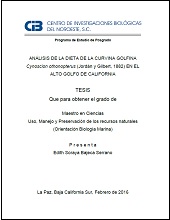| dc.contributor.advisor | Aragón Noriega, Eugenio Alberto | |
| dc.contributor.author | Bajeca Serrano, Edith Soraya | |
| dc.date.issued | 2016 | es_MX |
| dc.identifier.uri | http://dspace.cibnor.mx:8080/handle/123456789/486 | |
| dc.description.abstract | El Golfo de California es uno de los mares más estudiados del mundo y con mayor
riqueza biológica, y toma mayor relevancia cuando se le ubica en el contexto
pesquero nacional. El noroeste de México aporta del 50 al 65% de las capturas a
nivel nacional. La curvina golfina (Cynoscion othonopterus) se captura en tres
poblados: Golfo de Santa Clara, San Felipe y El Zanjón: localidades donde el
soporte económico principal es la actividad pesquera. Debido a ésto el
conocimiento de su biología básica es fundamental para mantener una pesquería
sustentable. El objetivo del presente estudio fue determinar la dieta de curvina
golfina mediante del análisis de su contenido estomacal. Las muestras se
obtuvieron durante los meses de marzo y abril de 2013 y 2014 en el Alto Golfo de
California. La recolecta se realizó con el arte de pesca denominado chinchorro de
línea, con luz de malla de 5.75”pulgadas. A los organismos se les registró la
longitud total (LT), longitud patrón (LP), peso, sexo y talla. Se recolectaron y fijaron
los estómagos en solución Davidson para posteriormente analizarlos en el
laboratorio. Se analizaron un total de 281 estómagos, donde el 58% presentaron
algún contenido y el 42% restante se encontraron vacíos. Usando los métodos
gravimétricos, frecuencia de ocurrencia y numérico, se encontró que la mayor
proporción en los contenidos estomacales correspondió a sardina bocona
(Cetengraulis mysticetus), seguida de camarón (Litopenaeus spp.) y jaiba
(Callinectes spp). El índice de importancia relativa colocó a C. mysticetus como la
presa preferida por C. othonopterus durante su etapa reproductiva y en la región
del Alto Golfo de California. El resultado de mayor relevancia es que la dieta no ha
cambiado en más de 20 años desde que se realizó el primer estudio de contenido
estomacal de curvina golfina en la región a pesar de los grandes cambios que han
ocurrido en el hábitat de reproducción de la especie. | es_MX |
| dc.language.iso | Español | es_MX |
| dc.publisher | Centro de Investigaciones Biológicas del Noroeste, S.C. | es_MX |
| dc.title | Análisis de la dieta de la curvina golfina Cynoscion othonopterus (Jordán y Gilbert, 1882) en el Alto Golfo de California | es_MX |
| dc.type | Tesis | es_MX |
| dc.documento.id | bajeca_e | es_MX |
| dc.documento.inst | CIBNOR | es_MX |
| dc.dirtesis.grado | Maestría en Ciencias en el Uso, Manejo y Preservación de los Recursos Naturales | es_MX |
| dc.dirtesis.disciplina | Biología Marina | es_MX |
| dc.dirtesis.universidad | Centro de Investigaciones Biológicas del Noroeste, S.C. | es_MX |
| dc.dirtesis.facultad | Posgrado en Recursos Naturales | es_MX |
| dc.documento.fecha | 2016-03-01 | |
| dc.description.abstracten | The Gulf of California is one of the most studied seas in the world because of its
great biological richness, and it becomes more relevant when placed at the
national fisheries context. In northwestern Mexico it contributes from 50 to 65% of
catches nationwide. The Gulf corvina Cynoscion othonopterus is captured by three
villages: Golfo de Santa Clara, San Felipe, and Zanjon, locations where the
support of economic activity is fishing. One of the species of greatest economic
value in those three communities is the Gulf corvina, so knowledge of its basic
biology is essential to maintain a sustainable fishery. The aim of this study was to
determine the diet of the Gulf corvina by analyzing its stomach contents. The
samples were collected in the Upper Gulf of California during the months of March
and April of 2013 and 2014. The collection was carried out with gillnet called locally
as “chinchorro de línea” with a mesh size of 5.75 in .Total length (LT), standard
length (SL), weight, sex and height were recorded from each individual. The
stomachs were collected and fixed in DAVIDSON solution for further analyses in
the laboratory. A total of 281 stomachs were analyzed, in which 58% had food
remains and 42% were empty. The gravimetric, numerical, and frequency of
occurrence methods were used. The sardine Cetengraulis mysticetus (called
locally “bocona”) was found in greater proportion in the stomach contents. In
smaller proportion the shrimp Litopenaesus sp. and the swimming crab Callinectes
sp were found. The index of relative importance positioned C.mysticetus as the
preferred prey by C. othonopterus at this life stage and in this region. The most
important result is the diet has not changed for over 20 years since the first study
of stomach contents of Gulf corvina in the region was made despite the great
changes that have occurred in its breeding habitat. | es_MX |
| dc.documento.subject | Contendido estomacal; comportamiento de la dieta; Peces | es_MX |

